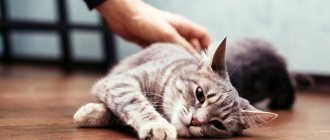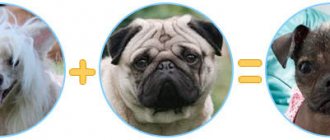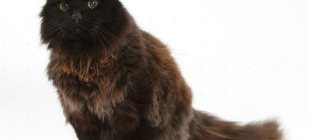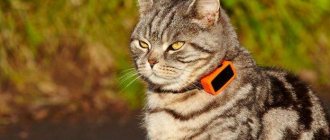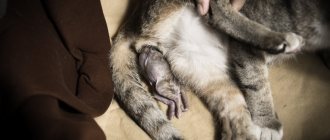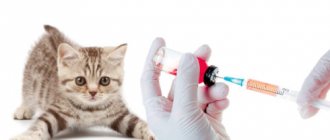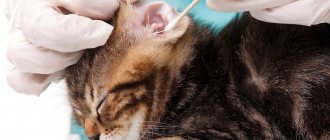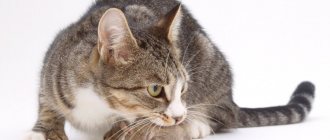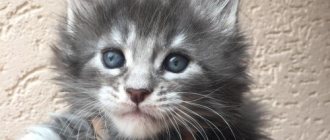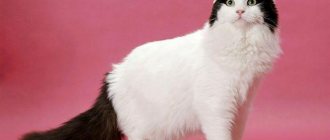Domestic cats are traditionally portrayed as good-natured and affectionate creatures, although expert opinions paint a completely different picture. According to the observations of experts, every cat is prone to demonstrating undisguised anger, and often uses aggression unmotivated when it strives for dominance and submission to its will. Let's find out which cats are on the list of the most dangerous breeds, and also figure out how to avoid attacks from them.
Ural Rex
This breed first gained popularity in pre-war times. But after the war, the number of these cats decreased, and for a long time they were considered to have disappeared forever.
But in the 60s, it became known about Ural Rex breeders, and the myth about the disappearance of the breed was dispelled, although the breed is still considered quite rare.
People who buy a handsome Ural cat most often think about its unusual appearance, but do not think at all about the unpredictable nature of this cat.
Most often, such cats behave quite friendly and affectionately, but at any moment the cat’s behavior can change in a sharply negative direction . So owners and their guests should beware of sudden bites from their pet.
Lazarus
A cat named Lazarus has one flaw that has made him popular on the Internet. The animal has a feline version of the cleft palate disease: the upper lip and part of the nose are missing, which is why the lower fangs are visible, like a vampire. He was found this way in Tennessee at ten weeks of age.
The cat was sheltered and looked after by a social worker. It was not easy: due to the constantly open mouth, the sinuses were constantly becoming infected, but the problem was solved with the help of surgery and antibiotics.
This cat's appearance is truly unforgettable.
All these cats are a vivid illustration of the saying that appearances are deceiving, because, like any animals, they respond to affection and kind treatment. We can only hope that their owners will not abuse the unusual external characteristics of their pets to their detriment.
Abyssinian cat
First of all, it is worth noting the unusual appearance of this cat.
Abyssinians do not look like domestic pets at all - from their color to the shape of their ears, they look like wild cats.
In character, this breed also resembles not affectionate domestic cats, but wild, dangerous predators . Moreover, Abyssinians treat their owners and other animals in the house quite friendly and affectionately.
But as soon as a stranger appears in the house, jealous surveillance begins. At any moment, the Abyssinian cat is ready to defend its territory and will gladly scratch your guest’s skin at any opportunity.
How to explain a cat's character
The character of a cat depends on the following features:
- heredity. If the animal's mother was evil, then it is likely that the "baby" will be the same. And the point here is not in upbringing, but in genes. Typically, a given cat breed has the same personality. If the animal is not purebred, then it can inherit any character - from mom or dad - this is a kind of lottery;
Outbred kittens can inherit the character of both mom and dad
- education. But it also matters. For example, if a cat nursing cubs was wary of people, then the kittens will behave the same way. It has been scientifically proven that the cat father, who does not take part in the upbringing of the offspring, also influences the upbringing of children, laying it down during embryonic development;
- place of birth. If a kitten was born on the street and is not used to people until 4 months old, then it is unlikely that he will be able to do this. Accordingly, he will retain the character of a predator and will hardly be able to become affectionate;
- color For example, animals with striped skin are freedom-loving, but black “Murks”, oddly enough, are considered the best pets for people;
- floor. Cats are more affectionate than cats, while male owners are arrogant, usually they are not ready to reconcile with their owner.
Keith Jenkins, director of an animal assistance company in the USA, is sure that the character of a cat can be determined by the expression of its face. And all because of hormones that affect the growth and shape of the animal’s bones, as well as its character and behavior.
Chausie
Aggressive jungle cats took part in the selection of this breed. Representatives of the reeds have never been distinguished by a calm character, and they passed this heritage on to their descendants Chausi.
“Wild” blood makes itself felt in the character of any cat of this breed . But the aggressive nature of these cats can be curbed with proper, strict education. You need to give your kitten enough attention from an early age, and then he will grow into a well-mannered pet.
But if the owner does not have time to communicate with his pet, then baby Chausie will grow into a naughty cat who is capable of doing completely unthinkable things. The owner can expect not only scratched hands, but also a house turned upside down.
Features of aggression
An inexperienced cat owner also needs to realize that his pet will not get angry for no reason, simply because he is harmful. Cats tend to become aggressive in certain circumstances that may pose immediate danger to them or appeal to their dormant hunting instincts.
Types of cat aggression
The types of aggression in cats do not imply any clear classification; rather, it is a set of typical everyday situations in which the animal’s behavior changes in a negative direction for the owner. Such situations include:
- intraspecific aggression;
- redirected aggression;
- aggression during affection;
- aggression during play;
- aggression based on fear;
- aggression caused by pain.
Cat aggression always has certain prerequisites
We will talk about each of these types in subsequent chapters.
Intraspecific aggression
This type of aggression involves competition between two cats driven by a specific goal. This aggression can be expressed either directly in a fight or indirectly (when direct contact is impossible). It also happens that a domestic cat “settles scores” with a yard cat, looking intently at him from the window. It doesn’t come to a fight, but the tension that accumulates in your pet from such “exercises” certainly makes itself felt.
Intraspecific aggression occurs in both males and females
The main causes of intraspecific aggression are:
- the appearance of a new cat in an apartment or house;
- meeting a cat that your pet has not seen for a long time and has forgotten;
- competition for any resource: food, territory, females.
Redirected aggression
It is this type of aggression that most inexperienced owners fail to understand. It would seem that there were no reasons for conflict, but suddenly the pet grabbed your arm or leg and did not let go. The reason for such aggression is frustration, which could arise from the same inability to meet the yard cat that we wrote about above and truly “sort things out.” As a result of this impossibility, the cat has to suppress himself and redirect his energy in another direction, to “win back.”
The reasons for redirected aggression often remain unclear to the owner
Aggression during petting
Many owners are very familiar with the situation when a couple of seconds ago a pet purring and basking on their lap begins to bite and scratch the hands that were caressing it. The reason for such “cunning” is not the malice of the animal, but its limited need for physical contact. From an overabundance of touches, a cat can easily become overexcited and not control its impulses, although it does not wish harm to anyone. Therefore, it is important to listen to your animal's needs and not go beyond his comfort zone.
Aggression can overtake a cat at the most unexpected moment for a person.
The main causes of aggression during lacquering are:
- the presence of sore spots in the cat that the owner accidentally came into contact with. If you find a constant negative reaction from the animal when you touch its stomach, then it makes sense to take the cat to the veterinarian;
- owner's intemperance. Some owners can be affectionate with their pet for hours, and although it brings them pleasure, the cat may find such a pastime tiresome and even unbearable. It is necessary to understand that not only people, but also animals have personal boundaries;
- congenital hypersensitivity. Some cats are simply not created for tactile contact and cannot become a fluffy ball for the owner that can be petted for hours. All that remains to be done in such a situation is to come to terms with this peculiarity of the pet.
Not all cats respond positively to tactile contact.
Aggression during play
This type of aggression is quite harmless and is expressed in various ways:
- the cat runs up to you from behind and hits you on the leg with its paw, after which it quickly runs away;
- the cat tries to jump to the person’s hands;
- the cat rushes back and forth without a specific goal;
- the cat disappears from sight, after which it suddenly jumps out at you from its hiding place.
Playful and hunting types of behavior easily transform into each other
Surely, the owner of every cat has encountered at least one of the above phenomena. From the outside, this behavior seems senseless, but in fact it is a manifestation of the pet’s hunting instincts in a playful way. Sometimes it happens that the cat forgets itself and goes on to a real attack, which you need to learn to recognize and stop in time.
Aggression based on fear
Cats that develop this type of aggression are considered to be naturally evil, ungrateful animals, incapable of receiving warmth and care from their owner. But, as we have already said, your pet cannot just be evil; he needs certain motives. The reaction to threat is developed in cats from a very early age and largely depends on the relationship with the mother.
Fears experienced by a kitten in early childhood become the cause of inadequate responses in the future.
If a kitten felt safe in the first months of its life, then most likely it will have fewer reasons to experience aggression when in contact with humans or other animals. That kitten, which for a number of reasons had to become independent too early, often becomes distrustful and closed, not inclined to make contact. For example, distrust is characteristic of stray cats.
The cat's mistrust of people causes his frequent aggressive outbursts
Subsequently, such distrust of the world around us manifests itself in various ways:
- cat aggression directed at the veterinarian;
- attempts to “eliminate” guests and other strangers from the house;
- the difficult process of getting used to a new pet or small child in the house.
Aggression caused by pain
As we already said in the chapter on aggression during petting, cats can react sharply to touching certain parts of the body when a certain pathology occurs. Since animals do not have the ability to verbally describe their symptoms to their owner, they have to communicate their poor health through aggression.
Sometimes the reason for refusing affection is an undiagnosed pathology
Such aggression is also often confused with causeless aggression, which sometimes leads to worsening symptoms. Therefore, if you notice that your cat has suddenly “deteriorated in character,” watch him and see if he has other painful symptoms in the form of decreased appetite, weakness, temperature and other general signs indicating illness.
Aggression caused by mental instability
In very rare cases, cat aggression has no objective reasons and is associated with disorders of the animal’s central nervous system. A veterinarian should examine such pets, since even the most skilled owner will not be able to cope with an unbalanced cat on his own. Before going to a specialist, it is important to take a short medical history, which will allow the doctor to form a holistic impression of the animal. Supporting points that will make writing an anamnesis easier are given below.
History taking
Manul
Manul is one of those breeds that cannot be tamed . These cats are too freedom-loving and will never obey a person.
It is worth noting that the disobedience of the Pallas cat is primarily due to the fact that he is not a domestic cat, but a wild one. That is, these cats feel very comfortable living in natural conditions, but they are not adapted to living side by side with humans .
As soon as the manul senses danger, he will immediately attack the person. Its claws are considered very powerful by feline standards, and its fangs are 3 times longer than those of an ordinary cat. It is worth noting that Pallas cats not only behave aggressively, but also look quite menacing .
How does aggression manifest itself?
In the list of the most aggressive cat breeds you can find representatives of those species that are never perceived with caution. Moreover, it is in such groups that the greatest risk is hidden - careless behavior or accidental psychological provocation can seriously anger a pet.
This behavior was inherited by modern evil cats from distant predatory ancestors. Unlike other animals, which give advance warning of an impending attack, felines often attack suddenly.
However, if you can retreat and hide, any cat, angry by nature or just irritated, will take this opportunity.
The first sign of nervous excitement and accumulated anger is hissing. At the same time, a “ridge” of fur rises along the cat’s spine and its tail fluffs out.
Another sign of aggression that indicates readiness to attack is pinned ears and tail thumping on surfaces.
Savannah
The luxurious spotted color and rather impressive size of the savannah bring to mind associations more with a reduced sevral than with an ordinary domestic cat.
This cat breed is distinguished by fairly high intelligence. They are smart, always loyal to their owner and easy to train.
The owner can raise an excellent friend and companion from a cat of this breed, but other people around will forever remain strangers to her . Therefore, she will want to attack guests at home or passers-by on a walk if she feels that they pose a danger to the savannah itself or to the owner.
Strange and unusual
Representatives of a breed called Laperm are called strange and even scary cats. The first kitten of this unusual breed was born in Dallas in the early 80s of the last century. Therefore, this breed can also be considered relatively young. A characteristic feature of cats is their unusual fur. It seems that the pet received a not entirely successful perm. Many cats look unkempt and a little strange because of such an unusual coat. Therefore, pets of this breed are often included in the rating of ugly cats.
Devon Rex - cats of this breed are also called elves by many. And all because they have unusual and large ears, reminiscent of the ears of fairy-tale creatures. Cats of this breed have other distinctive features. For example, this is an unusual cheekbone muzzle and special fur. The fur of these cats is very soft, delicate and slightly wavy. These cats are distinguished by their sociability and friendliness. They love affection, active and active games.
Read with this
- My gentle and affectionate cat: 15 breeds
- What does a ginger cat bring into the house, what does it stick to: signs, beliefs and superstitions
- Castration of a cat: pros and cons. cat behavior after castration
- An expression of love or a way to relax: why do cats purr?
- Why do cats bury food? Why do cats bury food next to the water bowl after they eat? why do cats do this every time?
- Why does a cat need a tail?
- How did cats originate?
- How to pet a cat correctly
- Fat white affectionate cat
- How long do cats sleep per day?
British Shorthair
Short-haired graceful cats, which have become a real treasure of Great Britain, have always captivated people from all over the world with their unusual muzzle shape and incredibly beautiful coat.
By nature they are quite independent and calm. The British breed is one of the most popular in the world.
But the British are not at all good-natured . Most often, these cats are not attached even to their own owner and in every possible way show how important personal space is for them.
If he does not want a person to pick him up or stroke him, the cat will demonstrate his reluctance by scratching and biting him.
And we are from Africa
The African savanna is something indescribable. Mixed serval and domestic cat. It is so beautiful that you want to admire it again and again. A very angry cat - is this really about such a beauty? Alas, there are few. Yes, the breed is extremely smart and inquisitive. These cats are so devoted to their owners that they are compared to dogs. And yet devotion does not at all prevent savannahs from showing aggression towards people.
jungle cat
Jungle cats are still considered wild , despite the fact that more and more people are expressing a desire to have a representative of this breed at home.
People are most often captivated by the resemblance of this unusual cat to a lynx. The charming tufts on the ears and the massive size of the jungle cat certainly look beautiful.
But nevertheless the natural predatory habits of the breed make themselves felt, and experts generally advise against keeping a jungle cat at home because of its evil and unpredictable nature.
Attention! People who have small children living in the house should especially beware of purchasing this breed. It is no easier to tame a jungle cat than it is to tame a lynx or a cheetah.
Aggression in hybrids and wild cats
All types of hybrid animals, especially those in the first, second and third generations from wild ancestors, are not recommended to be kept in a house where there are small children. However, this does not mean that these animals are prone to aggression. It’s just that the natural instincts of such cats are manifested to a greater extent than in varieties domesticated for centuries. It is interesting that most often it is hybrid breeds that never release their claws. For example, Chausie, even in a state of fear, will wave away, hit with his paw, but not scratch or bite.
Chausie or houseie
These animals have an independent character and do not like to be cuddled excessively, forcibly picked up, or treated like a toy doll. If you treat these cats with respect, taking into account their temperament, they will never show causeless aggression.
If a wild animal is kept at home, then with the onset of puberty it will most likely have to be transferred to an enclosure. Any such animal is easily aroused by the smells of the opposite sex, even those belonging to a different species.
Read the article about Chausie cats.
Wild and hybrid cats that are widely kept at home and dangerous to be left unsupervised with small children:
- Serval;
- Caracal;
- House;
- Ocelot;
- Puma;
- Bob-cat (Canada lynx);
- Savannah;
- Caraquet;
- Chausie;
- Bengal;
- Toyger;
- Safari.
Maine Coon
Representatives of this breed delight people with their stern appearance and massive body. In size, they are almost twice the size of ordinary cats.
They are distinguished not only by their beautiful and unusual appearance, but also by their flexible mind and high intelligence.
Maine Coons by their nature are real phlegmatic people. They are quite calm and confident. However, if you raise a Maine Coon incorrectly, you can end up with frequent hissing and attempts by the cat to bite or scratch not only strangers, but also its own owner .
However, you should not think that aggressive individuals are common among Maine Coons. Rather, the aggression of this breed is the result of improper upbringing or lack of proper attention of the owner to the cat person.
Causes of aggressive behavior
All domestic cats have the same reasons for their anger. In the first place are breed qualities. Bengals, British, Siamese cats have an innate tendency towards aggression. It manifests itself differently in everyone, but the predisposition is fixed by genetic development.
The second reason is improper upbringing. Any cat can become evil, even if it belongs to the order of decorative tigers or harmless ragamuffins.
Third – living conditions and stress. Loud sounds, unusual smells, lack of attention from the owner - the cat evaluates all the circumstances and reacts to them. Also, a cat’s mood changes during the mating period.
Siamese cat
Siamese cats are considered one of the most beautiful in the world. This breed is very popular not only because of its beautiful appearance, but also because of its high intelligence.
These cats are very smart and easy to train. They are easy to train and even loyal to humans. But in addition to high intelligence, these cats also received phenomenal memory.
Once an owner offends a Siamese cat at least once, he will remember it forever . And not only will he remember, but he will also want to take revenge at the moment when the enemy is unarmed.
There are many examples of Siamese cats attacking their owners while the latter were sleeping in bed. Therefore, you should not offend Siamese cats or treat them unfairly.
Ukrainian Levkoy
The rating of cats a la Frankenstein continues with another hairless cat. This experimental breed combines the incongruous: the floppy ears of the Scottish Fold and the hairless body of the Don Sphynx. Surprisingly, the work to create a cat with such an appearance was deliberate. This feline Frankenstein is not an accidental mistake of nature, but the work of human hands.
“Terrible on the face, kind on the inside” - this is about the Levkoy. They are active, loving, and constantly crave human attention. You won’t have time to sit down in your favorite chair, and your cat will already be curled up on your lap.
Price
In Russian nurseries - from 10,000 to 25,000 rubles; in Ukrainian – 2,500 – 5,500 UAH.
Author's comment
Fans of “bald folds” need to save their pets from the cold in winter and from open sunlight in summer.
It will be interesting: the top 15 popular cat breeds.
Bengal cat
It is no secret that Bengal cats were bred by crossing domestic cats and wild ones. Therefore, in the character of this breed, the temperament of a gentle domestic cat and the burrows of a real wild, unbridled predator are intricately crossed with each other.
In normal circumstances, Bengals are quite calm and serene animals, whose behavior is no different from other domestic cats. However, if it seems to them that there is danger somewhere nearby, the hunting instinct takes over. Therefore, Bengal cats can seriously harm humans .
It is also worth noting that this breed is practically not trainable .
Cat breeds with the most evil character
To have a pet, you first need to understand how to care for it. And the main thing is to figure out whether the household will suffer from it. Below are the most evil cat breeds in descending order, starting with the most evil.
Savannah
Savannah is a hybrid of the African serval and a domestic cat. The animal weighs about 14 kg, and its height at the withers can reach half a meter. The color of the savannah is sandy, with black spots and stripes. The appearance of this animal was long-awaited - scientists tried for many years to breed a large domestic cat, and in 1986 they succeeded. If raised incorrectly, the savannah can be aggressive, because its ancestor is a wild animal. And she will be wary with strangers, and when trying to pet or pick her up, she may bite or scratch. Therefore, a person who wants to have such an animal needs to think in advance about the pet’s living conditions. For example, organize an enclosure in the yard, where the cat can calmly expend energy and not spoil household items. This means that the animal will be satisfied and not angry.
If the right conditions are created for the savannah, the animal will be happy and not angry
Chausie
Chausie is a cross between a marsh lynx and an Abyssinian cat. Its weight is 4–10 kg, and its height is up to 40 cm. This domestic cat has an external resemblance to a puma, except that it is smaller in size, and its eyes are not wild. The animal loves independence and space, and if it is limited, then for lack of satisfaction it becomes aggressive. The color of the cat is black, silver or brownish. These cats do not like to be held for long periods of time, even if they treat their owner well.
Chausie should not be limited, otherwise the cat will become aggressive.
Bengal
The Bengal cat is a hybrid of its wild ancestors and a domestic cat. The animal weighs 4–8 kg and its height is 20–30 cm. This domestic cat has a rather impulsive character. Regular exercises help expend the animal's energy, and it is good if the owner takes part in them. The cat must be treated kindly and patiently. If you raise your voice at her, this will provoke aggression. When a cat feels that a person is unkind to her, she may injure him.
The Bengal cat has a rather impulsive character.
Siberian
The Siberian cat is beautiful - she has thick fur and expressive eyes. But at the same time, this animal is characterized by unpredictability. If you have not earned trust, then it is unlikely that you will be able to pet the cat. Usually the animal treats well only its owners, and may bite a stranger who wants to caress it. The Siberian cat comes in a variety of colors, from white to dark brown. Its weight is 3–9 kg, and its height at the withers is 30–40 cm.
The Siberian cat is unpredictable and can be aggressive
Siberian cats once lived in forests, but over time they became domesticated. They are good mouse and rat catchers.
When I was at school, someone gave my mother a large black and white Siberian cat, Barsushka. Something happened to his owners and the cat was left without a home. Mom was worried that he would not cope well with the move and that he would be stressed. Maybe there was, but somehow I didn’t observe it outwardly. The cat behaved very calmly, he immediately took a liking to a place on the table and there he kept himself in order all the time. But he wasn’t particularly affectionate - somehow he cared more about himself. But if he didn’t like something, he took it calmly. He lived with us for 2 years, and then some relative of his previous owner came and asked to give the cat back. We were sorry to part with it, but we had to give it away.
Abyssinian
An Abyssinian cat can be owned by people who have enviable patience. Even during play, this animal can bite and scratch. Human knees are not the place for her, since the animal prefers to be at a height all the time. In this position, it can attack at any moment. These animals are vindictive and unpredictable, but at the same time very curious - it is important for them to be in the center of events. The color of a cat can be different, from grayish to brown. The weight of the animal is 4–7 kg, height is 20–30 cm.
The Abyssinian cat can bite and scratch even during play.
British
The color of a British cat can vary from dark gray to white. The animal weighs 4–8 kg. British cats are quite capricious and proud, unapproachable and independent. They do not like to sit in their owner's arms and rarely allow themselves to be petted. If you pester them, they may bite. However, the patient attitude of the owner sometimes makes this animal docile.
The British cat is independent and unapproachable, which is why it seems aggressive
Maine Coon
The Maine Coon is a large cat, friendly and cute at first glance, but can injure a person. The fact is that he has a wayward character, and besides, the animal does not like to be left alone. A cat may regard a long absence of its owner as a betrayal. However, Maine Coons are easy-going and do not remember evil, and in order for them not to be aggressive, you just need to love them and spend a lot of time with them. Maine Coons are quite aggressive towards strangers.
Maine Coons can be aggressive towards strangers
Siamese
Siamese cats are real jealous people. They are vindictive and sometimes attack at unexpected times. It is especially dangerous to have such a pet if there is a small child in the house - the animal will be jealous of the owner and can harm the baby. Undoubtedly, the animal itself is beautiful, with an interesting color - the body is light, and the legs, muzzle and tail are dark. Such a cat weighs 3–5 kg, its height at the withers is 23–25 cm.
The Siamese cat is jealous, which is why it can be aggressive.
I remembered one incident from childhood involving a Siamese cat. My uncle, who lived next to us with his family, had just such a teenage animal. It rolled well along the curtains, digging into them with its claws, but otherwise gave the impression of a rather smart pet. He also had one peculiarity: when his uncle drank and came home a little “tipsy,” the cat, even from the farthest corner of the room, felt the alcohol fumes, ran headlong and attacked his drunken owner. The cat bit his uncle, scratched him, and could even hang on him, clenching his teeth. This story lay somewhere on the “shelf” of my childhood memory, but I only remembered it now.
Ethiopia here
The Abyssinian cat was not spared. This is one of the most ancient breeds. Its representatives lived in the territory of Ethiopia (formerly Abyssinia) already two thousand years ago. They were depicted next to the pharaohs. Such a high proximity did not affect the character of the cats. They do not have royal manners and behavior at all. Abyssinians are active and love to climb trees. They are attracted to heights. Curious and observant. In these 4 kg bodies beats the heart of a researcher. This breed will not let its owner get bored. But if he treats the pet without due respect, the cute cat is quite capable of explaining his ignorance to the owner. And the Abyssinian will use her own methods for this - cat methods. Claws and teeth will help her.
